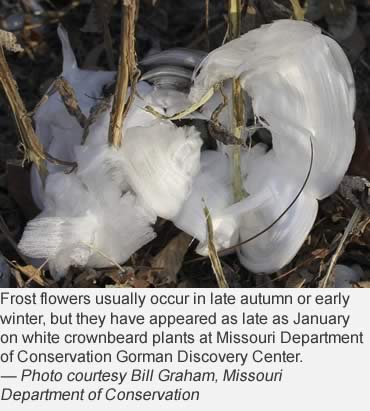Photo: For a few select species of plants, sudden cold snaps in autumn and winter can produce icy patterns, often called frost flowers. �— Photo courtesy Amanda Gehin, Missouri Department of Conservation
Unique icy blooms, often called frost flowers, make special appearances during late fall and winter in many areas of the country where certain native plants are easily found.
Lucky visitors to Missouri Department of Conservation Anita B. Gorman Discovery Center have been able to view frozen, twisted ribbons of ice arising on the lower stems of white crownbeard, a native wildflower planted in the Center’s outdoor garden.
Frost flowers are not really flowers at all, but instead are delicate, beautiful ribbons of ice crystals that form on the lower stems of several species of native plants in Missouri.
Good soil moisture and cold temperatures have produced numerous frost flowers on white crownbeard in recent months.
Only a few plants are known to create frost flowers. These are white crownbeard, yellow crownbeard, yellow ironweed and dittany if conditions are right.
Frost flowers have a brief existence, and disappear quickly on the day they occur, melting like frost when the air warms or rays of sunlight fall on the delicate structures.
Scientists are unsure why only these plants produce crystal ice patterns into ribbons or clusters that resemble flowers, and also why only certain types of plants are affected.
One theory is that their root systems stay active pulling up moisture from the soil, even though the upper parts of the plants go dormant in autumn. Another theory is that the stems rupture and crack in just the right way so sap oozing out forms into wide ribbons that freezes into the ice patterns.
Frost flowers often appear on plants when a sudden cold snap follows conditions that have kept soil moist and warm. Some descriptive accounts note frost flowers often vanish as quickly as sunlight strikes them.
 However, frost flowers have appeared with regularity on white crownbeard stems the past few years in the Gorman Discovery Center’s prairie garden, part of the Center’s outdoor teaching area.
However, frost flowers have appeared with regularity on white crownbeard stems the past few years in the Gorman Discovery Center’s prairie garden, part of the Center’s outdoor teaching area.
Frost flowers have appeared during the first hard freeze, have melted during warm ups, and have reappeared during subsequent freezes. They also have lingered for days in areas shaded from the sun if temperatures stayed at freezing or below.
Home gardeners can enjoy frost flowers by adding plants such as white crownbeard to gardens or native plant landscaping. White crownbeard, also called frostweed, produces clusters of white flowers from August into October.
They are tall plants and can reach 7 feet with enough sunlight or good soil, so they should be placed in gardens accordingly. Dittany is a smaller plant that produces purple flowers and may fit better in smaller, shaded yard plantings.
These native plants also benefit important pollinator species such as butterflies, moths and bees. Both white crownbeard and dittany bloom late into the growing season, a help to migrant species.
Winter brings stillness to gardens as green plants fade to browns and insects no longer buzz about. But with certain plants, the cold brings forth delicate white ice patterns.
Planting these species when spring arrives can provide a chilled bonus bloom in winter.
Information on frost flowers and plants that produce them is available here.
For an additional look at ice formations with daily freeze and thaw cycles, visit Illinois State University Professor Emeritus James Carter’s webpage.
— Contributed by the Missouri Department of Conservation